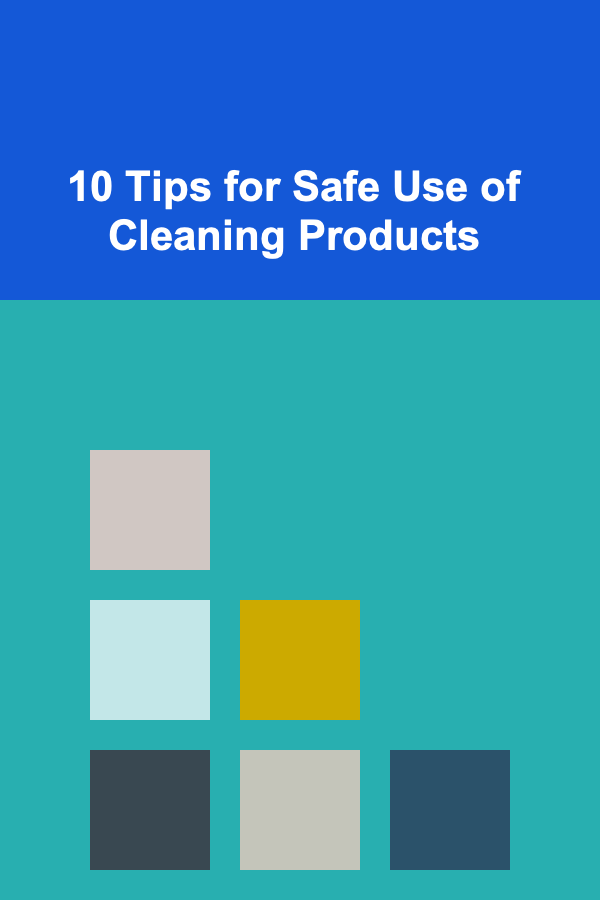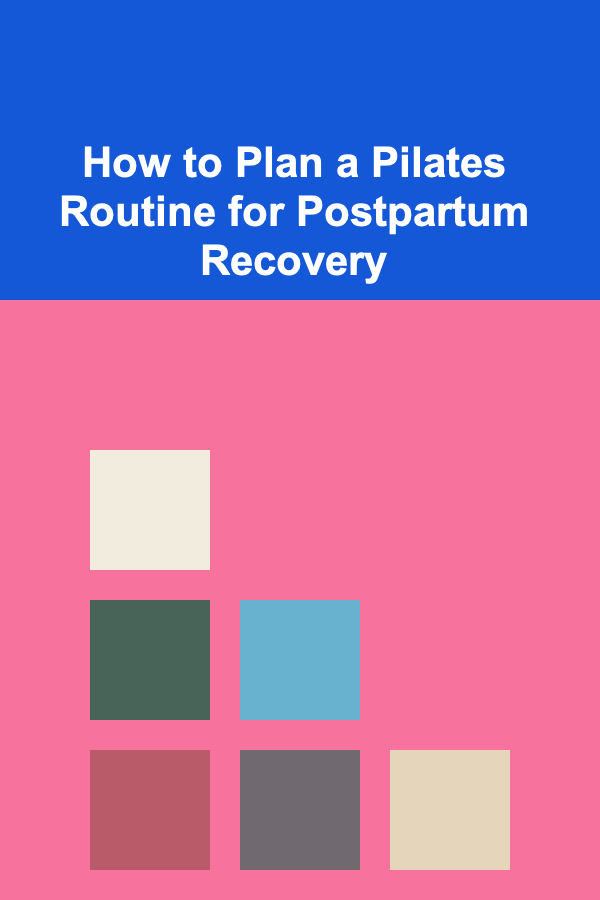
10 Tips for Safe Use of Cleaning Products
ebook include PDF & Audio bundle (Micro Guide)
$12.99$7.99
Limited Time Offer! Order within the next:

Cleaning products are essential in maintaining a clean and healthy living environment, but when used improperly, they can pose risks to both our health and the environment. Whether you're using household cleaners or industrial-grade products, understanding how to use them safely is crucial to ensuring your well-being and preserving the spaces you clean. In this article, we will explore 10 essential tips for the safe use of cleaning products, focusing on proper handling, storage, and precautions to minimize risks.
Read and Follow Label Instructions
Before using any cleaning product, it's critical to read the label carefully. Manufacturers provide instructions on how to use the product safely and effectively. The label may also include warnings about potential hazards, such as toxicity, skin irritation, or the need for ventilation during use.
Key Points:
- Ingredients List: Check for any chemicals that might be harmful to you, your family, or the environment. For example, bleach, ammonia, and certain disinfectants can be dangerous if not used correctly.
- Directions for Use: Always follow the recommended amounts, application methods, and any special instructions like "keep away from children" or "ensure proper ventilation."
By adhering to label instructions, you reduce the risk of accidents and ensure you're using the cleaning product in the way it's intended to be used.
Wear Protective Gear
Many cleaning products contain harsh chemicals that can irritate the skin, eyes, or respiratory system. To protect yourself, always wear the appropriate protective gear when using cleaning products.
Key Points:
- Gloves: Use rubber gloves to protect your hands from chemicals that can cause skin irritation, burns, or dryness.
- Safety Goggles: If there's a risk of splashing or spraying, wear goggles to protect your eyes from chemical exposure.
- Mask or Respirator: When using products with strong fumes (such as bleach or ammonia), wear a mask to prevent inhaling harmful vapors.
By wearing protective gear, you create a physical barrier between yourself and potentially harmful substances.
Ventilate the Area
Proper ventilation is key to preventing the accumulation of harmful fumes while cleaning. Many cleaning products release volatile organic compounds (VOCs) and other chemicals into the air that can cause respiratory irritation, headaches, or dizziness.
Key Points:
- Open Windows and Doors: Ensure good airflow by opening windows and doors during and after cleaning.
- Use Exhaust Fans: If available, use exhaust fans to help disperse fumes more quickly.
- Air Out the Area: Allow the cleaned area to air out after use, particularly if you've used products with strong or lingering odors.
Ventilation ensures that any fumes or chemical residues are minimized, making the space safer to be in once you've finished cleaning.
Avoid Mixing Cleaning Products
One of the most common mistakes people make when cleaning is mixing different cleaning products. Some chemicals can react with each other, creating toxic fumes or dangerous compounds that can harm you.
Key Points:
- Bleach and Ammonia: Mixing bleach with ammonia produces chloramine vapors, which can cause respiratory issues, chest pain, and even lung damage.
- Bleach and Vinegar: Mixing bleach with vinegar creates chlorine gas, which is highly toxic and can cause coughing, shortness of breath, and other severe respiratory problems.
Always check the label to ensure that the product is safe to use alongside other cleaners. When in doubt, use one product at a time and follow the manufacturer's guidelines for compatibility.
Store Cleaning Products Safely
Proper storage of cleaning products is essential for preventing accidents, particularly if you have children or pets in the home. Chemicals should be kept in a secure location, away from areas where they might be accidentally ingested or spilled.
Key Points:
- Out of Reach of Children: Always store cleaning products in a high cabinet or a locked storage area to prevent accidental poisoning.
- Temperature Control: Avoid storing cleaning products in areas with extreme temperatures, such as direct sunlight or near heat sources, as this can cause the chemicals to break down or become more volatile.
- Labeling and Organization: Store products in their original containers with labels intact. This helps you identify them easily and reduces the risk of mix-ups.
Safe storage ensures that cleaning products don't pose an unnecessary risk to family members or pets.
Dispose of Cleaning Products Properly
When cleaning products reach their expiration date or are no longer needed, it's important to dispose of them correctly. Many cleaning products contain chemicals that can be harmful to the environment if not disposed of properly.
Key Points:
- Follow Local Guidelines: Different regions have specific regulations for disposing of hazardous waste. Research your area's guidelines for the safe disposal of cleaning products.
- Do Not Pour Down the Drain: Never pour cleaning products down the drain unless the label specifically states it's safe to do so. Harmful chemicals can contaminate water supplies.
- Use Hazardous Waste Facilities: For products like paint removers, solvents, or other chemical cleaners, take them to a designated hazardous waste disposal facility.
Proper disposal prevents environmental contamination and ensures that hazardous materials are handled safely.
Keep Cleaning Products Out of Food Preparation Areas
To avoid contamination, it is best to keep cleaning products separate from food and food preparation areas. Even trace amounts of cleaning chemicals can cause food contamination and lead to foodborne illnesses.
Key Points:
- Never Store Cleaning Products in the Kitchen: Avoid storing cleaning products under the sink in the kitchen or near food items. Instead, store them in a separate, well-ventilated area.
- Rinse Surfaces Thoroughly: When cleaning countertops or kitchen appliances, always make sure to rinse surfaces thoroughly with water to remove any residual cleaning chemicals before preparing food.
By keeping cleaning products away from food, you reduce the risk of cross-contamination and safeguard your family's health.
Test Cleaning Products in Small Areas First
Before using a cleaning product on a large surface or item, it's a good idea to test it in a small, inconspicuous area first. This will help you ensure that the product won't cause damage or discoloration.
Key Points:
- Carpets and Upholstery: Test the cleaner on a hidden corner of the carpet or fabric to check for colorfastness or damage.
- Wood and Metal Surfaces: Certain cleaners can dull or damage surfaces like wood or metal, so it's crucial to test first.
By conducting a small test, you can avoid making costly or irreversible mistakes in your cleaning process.
Use Eco-Friendly Cleaning Products
Choosing environmentally friendly or non-toxic cleaning products is a safer and more sustainable choice. Many traditional cleaning products contain harmful chemicals that can be harmful to both your health and the environment.
Key Points:
- Biodegradable Ingredients: Look for products made from plant-based or biodegradable ingredients that break down naturally and cause less harm to ecosystems.
- Non-Toxic Formulas: Opt for cleaners that are free from harsh chemicals like chlorine, ammonia, or phosphates.
- Natural Alternatives: Consider making your own cleaning solutions using ingredients like vinegar, baking soda, and lemon juice, which can be just as effective as store-bought products without the harmful side effects.
Eco-friendly cleaning products are safer for both your health and the planet, providing peace of mind during cleaning tasks.
Keep Cleaning Products Out of Reach of Pets
Just as with children, pets can be at risk of exposure to cleaning products. Pets often explore their environment by sniffing or licking surfaces, so it's important to ensure that cleaning products are stored safely out of their reach.
Key Points:
- Pets and Chemicals: Many cleaning products contain chemicals that can be toxic to pets if ingested or if they come into contact with their skin.
- Clean Up Spills Immediately: If you accidentally spill a cleaning product, clean it up right away to prevent pets from coming into contact with it.
- Use Pet-Safe Cleaners: If you have pets, consider using pet-safe cleaning products that are specifically designed to be safe for animals.
By taking precautions with pets, you ensure that your cleaning efforts don't pose a danger to your furry friends.
Conclusion
Cleaning products are an essential part of maintaining a clean and healthy environment, but they must be used with caution. By following these 10 safety tips, you can minimize the risks associated with their use and ensure a safer living space for you, your family, and the environment. Always read labels, wear protective gear, ensure proper ventilation, and use eco-friendly products when possible. Safe use of cleaning products will protect your health, your home, and the planet.
Reading More From Our Other Websites
- [Organization Tip 101] How to Organize Craft Supplies Using Clear Containers
- [Biking 101] Best Bike Lights for Commuters: Illuminate Your Ride
- [Screen Printing Tip 101] Best Ways to Market Custom Screen‑Printed Merchandise to Niche Online Communities
- [Hiking with Kids Tip 101] Mini Adventures: Beginner Hikes Ideal for Kids Under $50
- [Organization Tip 101] How to Declutter Your Kid's Room in Five Simple Steps
- [Digital Decluttering Tip 101] A Step-by-Step Guide to Decluttering Your Phone with the Best Apps
- [Stamp Making Tip 101] Best Ways to Preserve Your Custom Laser‑Etched Stamps for Longevity
- [Survival Kit 101] Self-Reliance in the Digital Age: Mastering Independence with Technology and Resources
- [Polymer Clay Modeling Tip 101] Step-by-Step Guide: Crafting Your First Polymer Clay Pendant
- [Personal Care Tips 101] How to choose a dry Shampoo for All-day Freshness

How to Choose Flooring That Handles Wear and Tear in an Entryway
Read More
How to Create a Party Menu That Will Please Every Guest
Read More
How to Organize Your Fitness Challenges and Goals
Read More
How to Handle Long-Distance Dating
Read More
Gentle Parenting: Nurturing Growth, Not Obedience
Read More
How to Plan a Pilates Routine for Postpartum Recovery
Read MoreOther Products

How to Choose Flooring That Handles Wear and Tear in an Entryway
Read More
How to Create a Party Menu That Will Please Every Guest
Read More
How to Organize Your Fitness Challenges and Goals
Read More
How to Handle Long-Distance Dating
Read More
Gentle Parenting: Nurturing Growth, Not Obedience
Read More